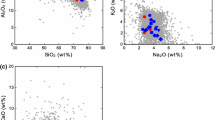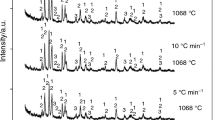Abstract
Degassing experiments showed that a remarkable difference exists between glasses from a range of geological environments. The released gases were thermally analysed by a simultaneous thermogravimetric, mass spectrometric (partial pressure), and total pressure measurements of evolved gases by heating from room temperature to 1450°C. Detailed degassing studies on natural glasses from various terrestrial environments show that the degassing behaviour of glasses differs strongly, also in respect of the manmade glasses. The gas release profiles of natural glasses can be divided into three groups: 1) volcanic glasses, 2) impact glasses and 3) silica glasses and tectites.
The degassing behaviour of manmade glasses is determined by the melting technique, the raw materials, and the fining agents. Gas release curves are suitable tools for the identification of vitreous samples of unknown origin but it is impossible to gain data of physico-chemical conditions of the glass formation process or for the polymerization state of the melt.
Zusammenfassung
Entgasungsexperimente zeigen, daß zwischen Gläsern von einer Reihe von geologischen Umfeldern bemerkenswerte Unterschiede bestehen. Die beim Erhitzen von Raumtemperatur auf 1450°C freigesetzten Gase wurden thermisch mittels simultanen thermogravimetrischen, massenspektrometrischen (Partialdruck) und Gesamtdruckmessungen analysiert. Ausführliche Entgasungsstudien an natürlichen Gläsern aus verschiedenen Landschaftsgebieten zeigen, daß sich das Entgasungsverhalten der Gläser stark unterscheidet, auch im Vergleich zu künstlich erzeugten Gläsern. Die Gasfreisetzungsprofile natürlicher Gläser können in drei Gruppen unterteilt werden: 1.) vulkanische Gläser, 2.) Aufschlaggläser und 3. Silikatgläser und Tektite.
Das Entgasungsverhalten künstlich hergestellter Gläser wird durch die Schmelztechnik, die Rohstoffe und die Läutermittel bestimmt. Entgasungskurven sind ein geeignetes Mittel zur Identifizierung glasähnlicher Proben unbekannten Ursprunges. Es ist jedoch nicht möglich, Daten über physikalisch-chemische Bedingungen der Glasbildungsprozesse oder über den Polymerisationsgrad der Schmelze zu erhalten.
Similar content being viewed by others
References
K. Heide, Chem. Erde, 33 (1974) 195.
C. M. Hampton and D. K. Bailey, J. Non-Cryst. Solids, 67 (1984) 147.
J. Götze, The influence of phenocryst content on the degassing behaviour of volcanic glasses, Poster Int. Volc. Congr., Mainz 1990.
E. Hartung and K. Heide, Silikattechnik, 35 (1984) 343.
Th. Stelzner, K. Heide and K. Kothe, Glass technology, 31 (1990) 236.
J. O'Keefe, J. Non-Cryst. Solids, 67 (1984) 1.
R.V. Fischer and H. U. Schmincke, Pyroclastic rocks, Springer-Verlag Berlin, Heidelberg, New York, Tokyo 1984.
K. Heide, Chem. Erde, 49 (1989) 287.
O. Leeder, R. Thomas and W. Klemm, Einschlüsse in Mineralien, VEB Deutscher Verlag für Grundstoffindustrie, Leipzig 1987.
G. Frenzel and V. Stähle, Chem. Erde, 41 (1982) 111.
J. V. Smith and W. L. Brown, Feldspar Minerals, Springer Verlag, 1987.
O. W. Flörke, S. Flux and B. Schröder, N. Jb. Mineral. Abh., 151 (1985) 87.
M. Pichavant, J. V. Herrera, S. Boulmier, L. Briqueu, J. Joron, M. Juteau, L. Marin, A. Michard, S. M. F. Sheppard, M. Treul and M. Verent, The Macusani glasses, SE Peru: evidence of chemical fractionation in peraluminous magmas, Magmatic Processes: Physicochemical Principles, The Geochemical Society. Spec. Pub. Ed. B. O. Mysen, No.1, 1987.
E. Mosheim, Chemische and physikalische Untersuchungen an geologischen und archäologischen Obsidianen der Ägäis, Dissertation Karlsruhe, 1984.
E Mosheim, Homogenitätsuntersuchungen an Obsidianen, ein Beitrag zur Erforschung prähistorische Handelswege, Diplomarbeit Karlsruhe, 1979.
Ch. Knoeberl, Ann. Rev. Earth Plant. Sci., 14 (1986) 323.
S. R. Taylor and S. M. McLennan, Geochim. Cosmochim. Acta, 43 (1979) 1551.
E. Luft, Zur Bildung der Moldavite beim Ries-Impakt aus tertiären Sedimenten, Ferninand Enke Verlag, 1983.
L. Pfeiffer, M. Kunze and G. Mathé, Einführung in die Petrologie, Akademie Verlag, Berlin 1985.
R. Shaw, Amer. J. Sci., 272 (1972) 870.
K. Heide and I. Perlaky, Zur Entgasung von Perliten; in Vorbereitung.
Author information
Authors and Affiliations
Additional information
Dedicated to Prof. Dr. H. J. Seifert on the occasion of his 60th birthday
Rights and permissions
About this article
Cite this article
Heide, K. The degassing behaviour of natural glasses and implications for their origin. Journal of Thermal Analysis 37, 1593–1603 (1991). https://doi.org/10.1007/BF01913491
Received:
Issue Date:
DOI: https://doi.org/10.1007/BF01913491




